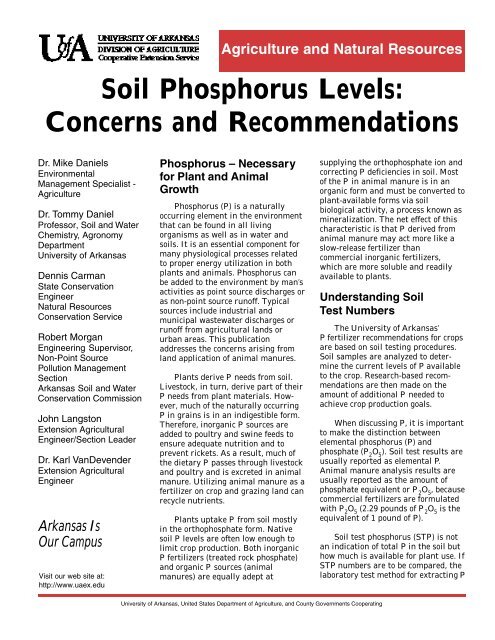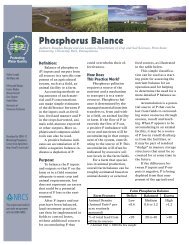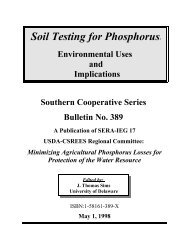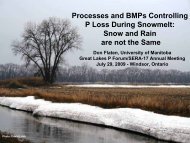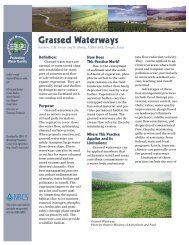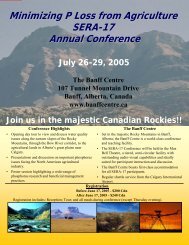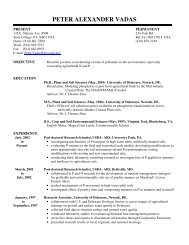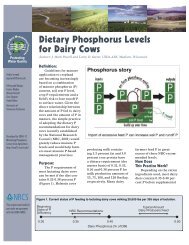Soil Phosphorus Levels: Concerns and Recommendations - Sera-17
Soil Phosphorus Levels: Concerns and Recommendations - Sera-17
Soil Phosphorus Levels: Concerns and Recommendations - Sera-17
You also want an ePaper? Increase the reach of your titles
YUMPU automatically turns print PDFs into web optimized ePapers that Google loves.
Agriculture <strong>and</strong> Natural Resources<br />
<strong>Soil</strong> <strong>Phosphorus</strong> <strong>Levels</strong>:<br />
<strong>Concerns</strong> <strong>and</strong> <strong>Recommendations</strong><br />
Dr. Mike Daniels<br />
Environmental<br />
Management Specialist -<br />
Agriculture<br />
Dr. Tommy Daniel<br />
Professor, <strong>Soil</strong> <strong>and</strong> Water<br />
Chemistry, Agronomy<br />
Department<br />
University of Arkansas<br />
Dennis Carman<br />
State Conservation<br />
Engineer<br />
Natural Resources<br />
Conservation Service<br />
Robert Morgan<br />
Engineering Supervisor,<br />
Non-Point Source<br />
Pollution Management<br />
Section<br />
Arkansas <strong>Soil</strong> <strong>and</strong> Water<br />
Conservation Commission<br />
John Langston<br />
Extension Agricultural<br />
Engineer/Section Leader<br />
Dr. Karl VanDevender<br />
Extension Agricultural<br />
Engineer<br />
Arkansas Is<br />
Our Campus<br />
Visit our web site at:<br />
http://www.uaex.edu<br />
<strong>Phosphorus</strong> – Necessary<br />
for Plant <strong>and</strong> Animal<br />
Growth<br />
<strong>Phosphorus</strong> (P) is a naturally<br />
occurring element in the environment<br />
that can be found in all living<br />
organisms as well as in water <strong>and</strong><br />
soils. It is an essential component for<br />
many physiological processes related<br />
to proper energy utilization in both<br />
plants <strong>and</strong> animals. <strong>Phosphorus</strong> can<br />
be added to the environment by man’s<br />
activities as point source discharges or<br />
as non-point source runoff. Typical<br />
sources include industrial <strong>and</strong><br />
municipal wastewater discharges or<br />
runoff from agricultural l<strong>and</strong>s or<br />
urban areas. This publication<br />
addresses the concerns arising from<br />
l<strong>and</strong> application of animal manures.<br />
Plants derive P needs from soil.<br />
Livestock, in turn, derive part of their<br />
P needs from plant materials. However,<br />
much of the naturally occurring<br />
P in grains is in an indigestible form.<br />
Therefore, inorganic P sources are<br />
added to poultry <strong>and</strong> swine feeds to<br />
ensure adequate nutrition <strong>and</strong> to<br />
prevent rickets. As a result, much of<br />
the dietary P passes through livestock<br />
<strong>and</strong> poultry <strong>and</strong> is excreted in animal<br />
manure. Utilizing animal manure as a<br />
fertilizer on crop <strong>and</strong> grazing l<strong>and</strong> can<br />
recycle nutrients.<br />
Plants uptake P from soil mostly<br />
in the orthophosphate form. Native<br />
soil P levels are often low enough to<br />
limit crop production. Both inorganic<br />
P fertilizers (treated rock phosphate)<br />
<strong>and</strong> organic P sources (animal<br />
manures) are equally adept at<br />
supplying the orthophosphate ion <strong>and</strong><br />
correcting P deficiencies in soil. Most<br />
of the P in animal manure is in an<br />
organic form <strong>and</strong> must be converted to<br />
plant-available forms via soil<br />
biological activity, a process known as<br />
mineralization. The net effect of this<br />
characteristic is that P derived from<br />
animal manure may act more like a<br />
slow-release fertilizer than<br />
commercial inorganic fertilizers,<br />
which are more soluble <strong>and</strong> readily<br />
available to plants.<br />
Underst<strong>and</strong>ing <strong>Soil</strong><br />
Test Numbers<br />
The University of Arkansas’<br />
P fertilizer recommendations for crops<br />
are based on soil testing procedures.<br />
<strong>Soil</strong> samples are analyzed to determine<br />
the current levels of P available<br />
to the crop. Research-based recommendations<br />
are then made on the<br />
amount of additional P needed to<br />
achieve crop production goals.<br />
When discussing P, it is important<br />
to make the distinction between<br />
elemental phosphorus (P) <strong>and</strong><br />
phosphate (P 2<br />
O 5<br />
). <strong>Soil</strong> test results are<br />
usually reported as elemental P.<br />
Animal manure analysis results are<br />
usually reported as the amount of<br />
phosphate equivalent or P 2<br />
O 5<br />
, because<br />
commercial fertilizers are formulated<br />
with P 2<br />
O 5<br />
(2.29 pounds of P 2<br />
O 5<br />
is the<br />
equivalent of 1 pound of P).<br />
<strong>Soil</strong> test phosphorus (STP) is not<br />
an indication of total P in the soil but<br />
how much is available for plant use. If<br />
STP numbers are to be compared, the<br />
laboratory test method for extracting P<br />
University of Arkansas, United States Department of Agriculture, <strong>and</strong> County Governments Cooperating
<strong>and</strong> how the number is reported (parts per million or<br />
pounds per acre) must be known. Different testing<br />
labs use different methods for extracting P, producing<br />
different test results that are difficult to compare<br />
even for the same sample. The University of Arkansas<br />
<strong>Soil</strong> Testing Laboratory uses the Mehlich III method,<br />
<strong>and</strong> the results are reported in pounds per acre of<br />
elemental P. Other soil testing labs may report their<br />
results in parts per million (ppm) without making the<br />
conversion to pounds per acre (lbs/A). This conversion<br />
from ppm to lbs/A involves assuming that a 6-inch<br />
deep layer of soil (furrow slice) covering one acre<br />
weighs 2,000,000 pounds. To convert soil test results<br />
from ppm to lbs/A, multiply the value in ppm by 2.<br />
For example, a soil test P value of 150 ppm is<br />
correlated to 300 lbs/A.<br />
The <strong>Phosphorus</strong> Concern<br />
Commercial fertilizers are commonly applied to<br />
cropl<strong>and</strong>s in a mixture of nitrogen, phosphate <strong>and</strong><br />
potash (N, P 2<br />
O 5<br />
, <strong>and</strong> K 2<br />
O) that is balanced to meet<br />
the nutrient needs of the desired crop. However,<br />
nutrients in livestock manure are not balanced with<br />
respect to crop requirements.<br />
TABLE 1<br />
Average Nutrient Values for Manure Samples<br />
Collected by Arkansas Producers*<br />
N P 2 O 5 P N/P 2 O 5<br />
Broiler Litter 56 54 23.6 1.04 Lbs/ton<br />
Dairy Manure 6 4 1.75 1.50 Lbs/1,000 gal<br />
Swine Manure 14 13 5.68 1.08 Lbs/1,000 gal<br />
*These values are derived from manure samples collected by<br />
producers <strong>and</strong> sent to the University of Arkansas Agricultural<br />
Diagnostics Laboratory. The nitrogen values are the total nitrogen<br />
concentration.The phosphorus values are the P 2 O 5 <strong>and</strong> P<br />
concentrations as marked.<br />
Table 1 reveals that N <strong>and</strong> P 2<br />
O 5<br />
are found in<br />
about equal amounts in broiler litter. However,<br />
Table 2 indicates that typical forage crops require<br />
about 2 1 ⁄2 to 4 times as much N as P 2<br />
O 5<br />
.<br />
TABLE 2<br />
Nutrients Removed Per Ton of Forage Dry Matter<br />
(Average of Arkansas Forage Tests from 1984-1996)<br />
N P 2 O 5 P K 2 O N/P 2 O 5<br />
pounds removed per ton of forage production<br />
Alfalfa 58* 14 6 56 4.14<br />
Bahiagrass 31 8 3 34 3.88<br />
Bermudagrass 40 12 5 44 3.33<br />
Clover 43* 12 5 44 3.58<br />
Fescue 36 14 6 50 2.57<br />
Legume/grass 39* 12 5 43 3.25<br />
Ryegrass 39 16 7 54 2.44<br />
Sudangrass 37 14 6 47 2.64<br />
Wheat 36 13 6 40 2.77<br />
*N from N fixation not N fertilizer<br />
Growers with confined livestock <strong>and</strong> poultry<br />
operations have tons of P-enriched feed brought onto<br />
the farm. Much of that P passes through the animals<br />
<strong>and</strong> is excreted in manure. In turn, the manure is<br />
spread on fields to take advantage of the nutrient<br />
value <strong>and</strong> organic matter. Crops most readily respond<br />
to nitrogen, so growers have historically applied<br />
enough manure to meet crop nitrogen needs. This<br />
results in applying several times the needed amount<br />
of P (refer to Tables 1 <strong>and</strong> 2 concerning nutrient<br />
values <strong>and</strong> the example application scenario below).<br />
EXAMPLE SCENARIO<br />
Comparing N vs P 2<br />
O 5<br />
Based Litter Applications<br />
This example is for a broiler farm consisting of four houses<br />
that places a nominal 20,000 four-pound birds per house<br />
<strong>and</strong> averages five flocks per year. The litter produced will<br />
be applied to produce 4 tons of fescue per acre.<br />
Assumptions<br />
• Litter is produced at a rate of 1 ton per 1,000 birds per<br />
flock.<br />
• The litter contains 60 lbs N/ton <strong>and</strong> 55 lbs P 2 O 5 /ton.<br />
• The fescue produced will contain 36 lbs N/ton <strong>and</strong><br />
14 lbs P 2 O 5 /ton.<br />
• 25% of the N is lost during litter application to<br />
volatilization.<br />
• No other mineralization, denitrification or leaching<br />
losses for N or P 2 O 5 are considered.<br />
Litter Nutrient Information<br />
• 400 tons litter/year<br />
• 18,000 lbs N available/year<br />
• 22,000 lbs P 2 O 5 available/year<br />
Fescue Nutrient Information<br />
• 4 tons fescue/A<br />
• 144 lbs N required/A<br />
• 56 lbs P 2 O 5 required/A<br />
Application Comparisons<br />
N Based<br />
P 2 O 5 Based<br />
• 125 A required • 393 A required<br />
• 3.2 tons litter/A • 1 ton litter/A<br />
• 144 lbs N applied/A • 46 lbs N applied/A<br />
• <strong>17</strong>6 lbs P 2 O 5 applied/A • 56 lbs P 2 O 5 applied/A<br />
• N needs met • 98 lbs N deficit/A<br />
• 120 lbs P 2 O 5 surplus/A • P 2 O 5 needs met<br />
Comment<br />
A P 2 O 5 surplus of 120 lbs/A does not imply that the STP<br />
will increase by 120 lbs/A. Due to soil chemical reactions,<br />
significant amounts of the surplus P will become bound in<br />
the soil <strong>and</strong> unavailable for plant use. Because soil test<br />
procedures were developed to indicate plant-available P<br />
they will not measure bound P. For this reason, a<br />
120 lbs/A surplus P 2 O 5 will increase the STP level by<br />
significantly less than 120 lbs/A.
Repeated application of manure based on<br />
nitrogen needs causes P to accumulate in the soil. In<br />
some cases, 10 years of repeated application has<br />
caused very high STP levels, particularly on pasturel<strong>and</strong>s<br />
where crops have not been removed. In the<br />
past, this build-up has not been a cause for concern.<br />
<strong>Phosphorus</strong> is a naturally occurring nutrient <strong>and</strong>,<br />
even at high levels, is not detrimental to crop production.<br />
It is also relatively stable once attached to soil<br />
particles. <strong>Phosphorus</strong> was once thought to have<br />
significant movement off fields only if soil was moved<br />
by erosion.<br />
For l<strong>and</strong> with high STP levels, it is now known<br />
that appreciable amounts of soluble P can exist in the<br />
runoff water from these areas <strong>and</strong> can significantly<br />
impact water quality in nearby streams <strong>and</strong> lakes.<br />
Looking at the top one inch of the soil profile, recent<br />
research has shown that the concentration of P in<br />
runoff increases as STP increases.<br />
FIGURE 1<br />
Relationship Between Mehlich III Extractable P in<br />
Captina Surface <strong>Soil</strong> <strong>and</strong> Dissolved Reactive P (DRP)<br />
in Runof (based on STP levels in the top 1 inch of soil)<br />
r 2 = 0.722<br />
p < 0.001<br />
<strong>and</strong> plant growth in water bodies. Insufficient P in<br />
most inl<strong>and</strong> water bodies keeps the clear water lakes<br />
<strong>and</strong> streams from being congested with algae <strong>and</strong><br />
aquatic vegetation. Very small increases in P can<br />
trigger unwanted algae <strong>and</strong> vegetative growth. <strong>Levels</strong><br />
of P exceeding critical values for algae growth can<br />
lead to the acceleration of eutrophication, the natural<br />
aging process of a lake that is characterized by<br />
excessive biological activity.<br />
Consequences of accelerated eutrophication<br />
include degradation of recreational benefits <strong>and</strong><br />
drinking water quality, which in turn can increase<br />
treatment costs. Advanced eutrophication can also<br />
reduce aquatic wildlife populations <strong>and</strong> species<br />
diversity by lowering dissolved oxygen <strong>and</strong> increasing<br />
the biological oxygen dem<strong>and</strong> (BOD). Eutrophication<br />
from excessive P has not generally been considered a<br />
public health issue like other contaminants derived<br />
from agricultural runoff, such as nitrates or pathogenic<br />
bacteria. However, there are toxic algae that<br />
can flourish with increases in available nutrients,<br />
which is causing researchers to focus more attention<br />
on the isolated events that have occurred in<br />
other states.<br />
How Much <strong>Soil</strong> Test<br />
<strong>Phosphorus</strong> Is Needed?<br />
Arkansas scientists agree that there is no<br />
agronomic reason or need for STP levels to be greater<br />
than about 80 to 100 pounds (P by Mehlich III<br />
extraction) per acre. Typical forage crops will<br />
annually remove from 8 to 16 pounds of P 2<br />
O 5<br />
per ton<br />
of production. As an example, bermudagrass removes<br />
about 12 pounds per ton or 72 pounds of P 2<br />
O 5<br />
annually for a 6 ton per acre crop. (Divide P 2<br />
O 5<br />
by<br />
2.29 to determine elemental P; 72 lbs P 2<br />
O 5<br />
= about<br />
31 lbs P).<br />
It must also be emphasized that P contained in<br />
plant material is recycled to the soil unless it is<br />
removed, either by crop or forage harvesting, soil<br />
erosion or runoff. On grazing l<strong>and</strong>, most P is recycled<br />
to the soil in manure. Only a small portion of the P<br />
uptake in the animal is retained <strong>and</strong> removed from<br />
the l<strong>and</strong> with the animal.<br />
Adapted from Sharpley, A.N., T. C. Daniel <strong>and</strong> D. R.Edwards,<br />
“<strong>Phosphorus</strong> Movement in the L<strong>and</strong>scape,” J. Prod.Agric., Vol.6, No. 4,<br />
1993.<br />
<strong>Phosphorus</strong> is not toxic <strong>and</strong> would not be a<br />
problem except P is the nutrient that limits biological<br />
activity in most of our clear water lakes <strong>and</strong> streams.<br />
Nitrogen <strong>and</strong> potash generally occur naturally in the<br />
environment in sufficient quantities to support algae<br />
The environmental concern of letting P<br />
accumulate to very high levels in the soil is the long<br />
period of time required to reduce STP to levels<br />
normally recommended for agronomic production.<br />
High levels of P can require as many as 15 to 20<br />
years of continuous crop harvesting for removal, with<br />
no additional P from any source during that time.
How Much <strong>Soil</strong> Test<br />
<strong>Phosphorus</strong> Is Too Much?<br />
A rigid, maximum STP level has not been set by<br />
soil scientists or the Natural Resources Conservation<br />
Service. However, one suggested limit that has been<br />
debated is 300 pounds P per acre (by the Mehlich III<br />
extraction testing method). This number has been<br />
suggested as an upper limit simply because it is<br />
much more than the available P needed for crop<br />
production (about three times more than needed),<br />
<strong>and</strong> it is hopefully low enough to avoid eutrophic<br />
runoff. The environmental impact of an STP level of<br />
300 lbs/A has not been established at this time. The<br />
variables <strong>and</strong> unknowns in the movement (transport)<br />
of P once it is in runoff water make its environmental<br />
impact difficult to assess. It should also be noted that<br />
the concentration of dissolved P in runoff water<br />
changes with rainfall intensity <strong>and</strong> duration, <strong>and</strong> the<br />
research has been under very specific rainfall <strong>and</strong><br />
runoff conditions.<br />
<strong>Soil</strong> test phosphorus is clearly a good indicator of<br />
when an appreciable concentration of dissolved P<br />
may be in runoff water. It does not, however, offer<br />
any indication of the amount (rate) of runoff water<br />
that may be generated for a given set of conditions.<br />
The total amount of P leaving a field is a function of<br />
the runoff P concentration <strong>and</strong> the runoff volume.<br />
The real issue is not the P concentration in runoff<br />
from the edge of any one field but the total P load<br />
transported to the stream or lake from an entire<br />
watershed. The maximum amount of P that can be<br />
assimilated in a watershed without causing eutrophication<br />
depends on a number of factors including<br />
STP levels. Distance from significant streams or<br />
water bodies, slope, soil type, buffer strips <strong>and</strong> crop<br />
or forage cover are potential factors, as are the<br />
characteristics of the streams <strong>and</strong> lakes themselves.<br />
However, soil testing, if properly used, may be the<br />
most significant tool for assessing the potential for<br />
high P concentrations in runoff water.<br />
<strong>Recommendations</strong> <strong>and</strong> <strong>Concerns</strong><br />
• An STP of 300 lbs/A is a good indicator that P<br />
build-up in the soil is a valid environmental<br />
concern for that particular field. Growers with<br />
management alternatives for manure or litter<br />
should reduce or totally avoid animal manure or<br />
P applications from any source on high P fields.<br />
Current scientific evidence is limited on how<br />
much P can be tolerated for all fields in all<br />
situations. However, it is known that high P<br />
fields can require as much as 15 to 20 years of<br />
continuous crop harvesting, with no added P<br />
during that time, to reduce high STP levels.<br />
Therefore, it is to the l<strong>and</strong>owner’s advantage not<br />
to let STP build to high levels if he has<br />
alternatives for management.<br />
• A STP of 300 lbs/A should not be considered an<br />
absolute maximum number for P applications at<br />
this time except in specific watersheds that have<br />
been determined to have excess P loads harmful<br />
to water quality <strong>and</strong> the environment.<br />
• Growers should be encouraged to make<br />
commercial fertilizer applications formulated<br />
with N <strong>and</strong> K 2<br />
O to meet the forage needs of fields<br />
where animal manure is no longer applied. It<br />
must be recognized that decreased fertility will<br />
result in a loss of forage cover <strong>and</strong> increased<br />
erosion, which could create a greater P problem<br />
in runoff than continued manure applications.<br />
Research has shown that when erosion is kept to<br />
a minimum, dissolved P is predominant in runoff<br />
water, but as erosion increases the percentage of<br />
particulate P in the runoff increases.<br />
FIGURE 2<br />
Percentage of Total P as Dissolved <strong>and</strong><br />
Particulate P as a Function of Erosion in Runoff<br />
from Watersheds at El Reno, Oklahoma<br />
The real issue is not the P concentration in<br />
runoff from the edge of any one field, but the<br />
total P load that is transported to the stream or<br />
lake from an entire watershed.<br />
Some watersheds with a high percentage of<br />
cropl<strong>and</strong> <strong>and</strong> pasturel<strong>and</strong> receiving animal manure<br />
may require restricted P applications to avoid excess<br />
P loading of streams <strong>and</strong> lakes fed by that watershed.<br />
Maximum STP levels may be appropriate for these<br />
watersheds. Watersheds with a low population<br />
density of livestock <strong>and</strong> poultry farms may be able to<br />
tolerate higher STP levels on fields without harmful<br />
effects to water quality. However, to effectively<br />
manage P in every watershed, the factors affecting<br />
the movement of P from application sites to streams<br />
<strong>and</strong> lakes must be considered.<br />
Adapted from Pote, D. H., T. C. Daniel, A.N. Sharpley, P. A.Moore, Jr.,<br />
D. R. Edwards, <strong>and</strong> D. J. Nichols, “Relating Extractable <strong>Soil</strong><br />
<strong>Phosphorus</strong> to <strong>Phosphorus</strong> Losses in Runoff,” <strong>Soil</strong> Sci.Soc. Am. J.<br />
60:855-859 (1996).
• When applying commercial fertilizer on fields<br />
with STP at 100 or more pounds per acre, do<br />
not use fertilizer with P in the formulation. It<br />
should be N (ammonium nitrate or urea) or<br />
N-0-K 2<br />
O, which is nitrogen <strong>and</strong> potash with<br />
no phosphorus.<br />
• When making N-based early season applications<br />
with manure, late season commercial fertilizer<br />
applications should be N or N-0-K 2<br />
O with no P in<br />
the formulation.<br />
• All livestock <strong>and</strong> poultry producers with confined<br />
animal operations should have a nutrient<br />
management plan prepared for their farm. The<br />
application rates should consider P. Low fertility<br />
fields with low P could have N-based applications<br />
for a limited time, but all fields with repeated<br />
animal manure applications will ultimately<br />
require applications that consider P.<br />
• Proper soil sampling techniques are critical to the<br />
accurate characterization of STP in pasturel<strong>and</strong>.<br />
Samples should be collected from 12 to 15<br />
locations within a field in a zigzag pattern across<br />
the field. These samples should be mixed together<br />
<strong>and</strong> a composite sample taken from the mixture.<br />
This provides the most representative sample<br />
possible. Also, care should be taken to collect a<br />
sample approximately 6 inches in depth.<br />
Producers are encouraged to contact their local<br />
county extension office for sampling instructions<br />
prior to sampling.<br />
• In Arkansas dry manure or litter is not regulated,<br />
<strong>and</strong> growers have more options for h<strong>and</strong>ling<br />
excess nutrients on their farms. Dry manure has<br />
a higher nutrient density <strong>and</strong> can be hauled<br />
greater distances than liquid manures with fewer<br />
economic hardships. Liquid manures in Arkansas<br />
are regulated, <strong>and</strong> growers have fewer options for<br />
h<strong>and</strong>ling excess nutrients. The permits specify<br />
the minimum required acreage <strong>and</strong> the l<strong>and</strong><br />
application areas for each farm.<br />
• Most livestock <strong>and</strong> poultry producers spread<br />
litter based on the best management practices at<br />
the time they started in business, only to find<br />
now that they may have inadequate l<strong>and</strong> for<br />
P-based application rates. As a result, restrictive<br />
P regulations could cause financial hardship<br />
for many producers <strong>and</strong> affect Arkansas’<br />
agricultural economy unless economically feasible<br />
alternatives to l<strong>and</strong> application are developed.<br />
High-quality water is also important for the<br />
economy <strong>and</strong> the people of Arkansas, so<br />
additional research is need to help producers find<br />
better ways to manage, utilize or market the<br />
valuable nutrients in excess manure.<br />
• Carefully prepared nutrient management plans<br />
for all confined livestock <strong>and</strong> poultry operations,<br />
implementation of current technology with best<br />
management practices <strong>and</strong> limited P applications<br />
in certain critical watersheds should protect our<br />
water until new research <strong>and</strong> good science can<br />
further define more specific P recommendations.<br />
• Additional solutions <strong>and</strong> management practices<br />
need to be developed <strong>and</strong> implemented. The areas<br />
of emphasis should include reducing the P<br />
concentrations in feeds while maintaining<br />
production, management practices to reduce the<br />
transport of P from the application areas to water<br />
bodies <strong>and</strong> the development of economical long<br />
distance transportation of manure to l<strong>and</strong> areas<br />
in need of P.<br />
References<br />
Sharpley, A. N., T. C. Daniel <strong>and</strong> D. R. Edwards,<br />
“<strong>Phosphorus</strong> Movement in the L<strong>and</strong>scape,”<br />
J. Prod. Agric., Vol. 6, No. 4, 1993.<br />
Pote, D. H., T. C. Daniel, A. N. Sharpley,<br />
P. A. Moore, Jr., D. R. Edwards <strong>and</strong> D. J. Nichols,<br />
“Relating Extractable <strong>Soil</strong> <strong>Phosphorus</strong> to<br />
<strong>Phosphorus</strong> Losses in Runoff,” <strong>Soil</strong> Sci. Soc.<br />
Am. J. 60:855-859 (1996).
DR. MIKE DANIELS is environmental management<br />
specialist - agriculture. JOHN LANGSTON <strong>and</strong> DR.<br />
KARL VANDEVENDER are Extension agricultural<br />
engineers with the Cooperative Extension Service,<br />
University of Arkansas, Little Rock. DR. TOMMY<br />
DANIEL is professor, soil <strong>and</strong> water chemistry, Agronomy<br />
Department, University of Arkansas, Fayetteville. DENNIS<br />
CARMAN is state conservation engineer, Natural<br />
Resources Conservation Service, Little Rock. ROBERT<br />
MORGAN is engineering supervisor, Non-Point Source<br />
Pollution Management Section, Arkansas <strong>Soil</strong> <strong>and</strong> Water<br />
Conservation Commission, Little Rock.<br />
Issued in furtherance of Cooperative Extension work,<br />
Acts of May 8 <strong>and</strong> June 30, 1914, in cooperation with<br />
the U.S. Department of Agriculture, Director,<br />
Cooperative Extension Service, University of Arkansas.<br />
The Arkansas Cooperative Extension Service offers its<br />
programs to all eligible persons regardless of race, color,<br />
national origin, sex, age, or disability, <strong>and</strong> is an Equal<br />
Opportunity Employer.<br />
FSA1029-4M-6-98N


